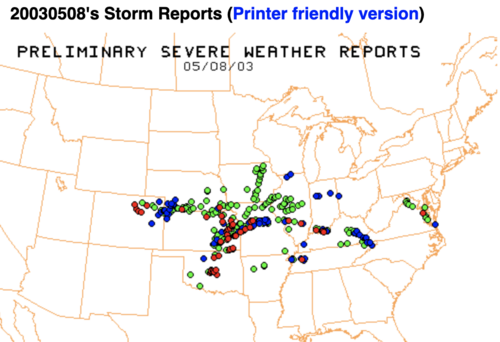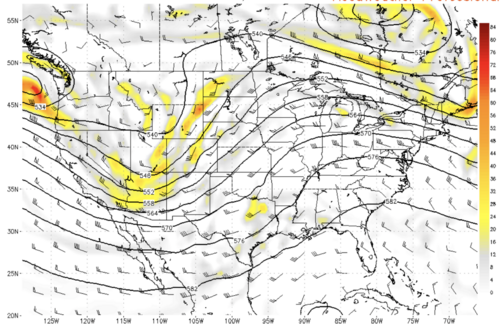Mike Smith
EF5
If the 12Z ECMWF is correct, there will be the most impressive Central Plains multi-day event in years.
From a pattern recognition perspective, it reminds me of May 3-8, 2003. The model's surface forecast is especially similar to May 8, 2003, but 2022 is, perhaps, 50 miles farther south based on that model's surface forecast. Both events show a strong negatively-tilted wave over the southern Rockies. The 2003 20Z SPC outlook is nearby. The SPC case history is here: SPC Severe Weather Event Review for Thursday May 08, 2003
The forecasted 2022 event has CAPE of 3,000+j and SWEAT of 700+, which is an extreme value. 250mb winds of 138kt are forecasted to overlay the area.
I have attached a photo of the F-3 Lyndon-Lawrence Tornado from 5-8-03. There were horizontal vortices, so the tornado might be underrated. The photo was taken through pouring rain from the supercell that produced the F-3 Yates Center Tornado. Hodographs are nearby.
My starting this thread is not to say there will be a high risk issued. I don't attempt to forecast what SPC might or might not forecast.
My primary reason for starting this thread is to provide some coaching info for young chasers who have not chased this type of event in the Great Plains.
From a pattern recognition perspective, it reminds me of May 3-8, 2003. The model's surface forecast is especially similar to May 8, 2003, but 2022 is, perhaps, 50 miles farther south based on that model's surface forecast. Both events show a strong negatively-tilted wave over the southern Rockies. The 2003 20Z SPC outlook is nearby. The SPC case history is here: SPC Severe Weather Event Review for Thursday May 08, 2003
The forecasted 2022 event has CAPE of 3,000+j and SWEAT of 700+, which is an extreme value. 250mb winds of 138kt are forecasted to overlay the area.
I have attached a photo of the F-3 Lyndon-Lawrence Tornado from 5-8-03. There were horizontal vortices, so the tornado might be underrated. The photo was taken through pouring rain from the supercell that produced the F-3 Yates Center Tornado. Hodographs are nearby.
My starting this thread is not to say there will be a high risk issued. I don't attempt to forecast what SPC might or might not forecast.
My primary reason for starting this thread is to provide some coaching info for young chasers who have not chased this type of event in the Great Plains.
- Two days of the 2022 ECMWF look almost exactly like May 8.
- In situations like this, you will likely have to pick a single supercell as the storms will move ~50-55 mph.
- Tail-end charlie, with both kinematics and thermodynamics forecasted to be this strong, will not necessarily be the best choice. I'd choose just NE of any dry line mesolow and/or a cell on the warm front.
- The ECMWF, this far out, has an east bias of about 50 miles.
- If possible, pick the "green" areas on the StormTrack road + visibility map. Green area looks well-matched to the threat on the final day (14th).
- Wichita, other factors equal, is probably the best airport to fly into if you are using that mode of transportation.
Attachments
Last edited:













